Don’t let its name fool you: in between shiny “phablets” and robot armies, Gizmodo still makes time for the ultimate old-school entertainment and educational device, the book. When Gizmodo‘s new editor-in-chief (and my Venue collaborator), Geoff Manaugh, asked me to contribute my top ten books of 2013 to their end-of-year “Best Books” list, I agonised for a very long time, and came up with the following.
Edible Geography’s Best Books of 2013
Forget quick-and-easy dinner suggestions: the Edible Geography top ten books of 2013 all sit firmly within the growing genre of writing about food as a way of writing about ideas, though you will find the odd recipe for bioluminescent durian sauce and a sauerkraut-kimchi hybrid. But what you lose in kitchen instructions, you gain in an awe-inspiring mix of gene-hacking, container shipping, fecal humour, and food porn wizardry.
From The New York Times best-seller that even your mum has heard of (Michael Pollan’s Cooked) to the artist-published manifesto for a new, open-source food-tech movement (the Center for Genomic Gastronomy’s Food Phreaking), this list compiles the most exciting ways of thinking about, and with, food that crossed my plate in 2013.
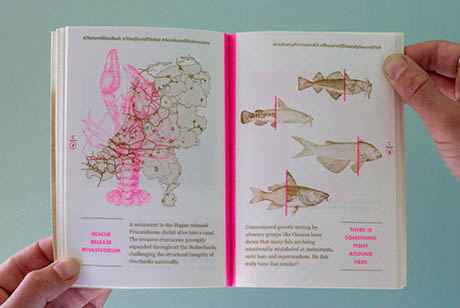
IMAGE: A spread from Food Phreaking. Photograph via the Center for Genomic Gastronomy.
Food Phreaking: Issue #00
This short but bold manifesto, published by the Center for Genomic Gastronomy, is available both as a free PDF and also as a rather gorgeous neon-pink-and-gold booklet. In it, artists Cat Kramer and Zack Denfield provide 38 examples of “what Food Phreaking might be, and what it most definitely is not.” From DIY suggestions such as Colony Collapse Cuisine (“Why not limit yourself to a diet of non-bee-pollinated ingredients? Taste the future, today. And be prepared for bio-adversity.”) to examples of culinary civil disobedience and outlaw ingredients (grey market raw milk vending machines, seed saving clubs, and beans tattooed with DNA-laced ink), the result is a mini-encyclopedia of stories at the fertile intersection of food, technology, and open culture.
Pandora’s Lunchbox: How Processed Food Took Over the American Meal
Although it inexplicably received much less attention that Michael Moss’s simultaneously released Salt, Sugar, Fat, Melanie Warner’s Pandora’s Lunchbox is the behind-the-scenes look at the food processing industry that will truly blow your mind. Who knew that the world’s largest manufacturer of Vitamin D, which is added into nearly all the milk that Americans consume (including organic varieties), is a factory in Dongyang, China, whose raw material is grease derived from Australian sheep’s wool? Or that genetically engineered enzymes are routinely used to boost apple juice yield, stop cookie batters from clogging factory nozzles, and make soybean oil transfat-free — and they don’t have to be declared on the end product label? Warner makes a convincing case that these industrially engineered food-like substances (which make up an estimated 70 percent of the American diet) are an entirely alien form of nutrition, and “if we really are what we eat, then Americans are a different dietary species from what we were at the turn of the twentieth century.”
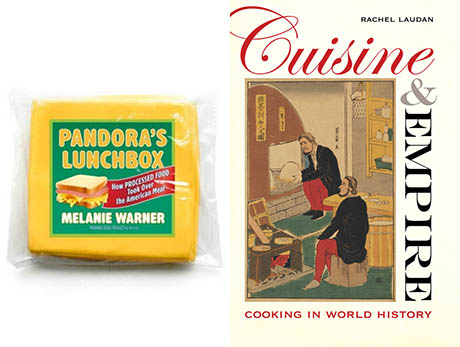
IMAGE: Cover art for Pandora’s Lunchbox and Cuisine & Empire.
Cuisine and Empire: Cooking in World History
This is a weighty book, spanning three thousand years of human culinary history from the steamed millet mush of 1000 BCE to the foams, spheres, and encapsulations of the present day, and it starts very slowly indeed. The patient reader, however, is rewarded: Laudan’s broad scope allows her to draw out previously obscure linkages and patterns (for example, she identifies the last lonely traces of Islamic culinary techniques in European cookery: Italian salsa verde, English mint sauce, and Catalonian picada), as well as convey the enormous (and, now, often overlooked) benefits of industrial food processing, as a release from the inadequate diets and hours spent grinding wheat or corn that characterized life for 99 percent of the world before the nineteenth century.
In the end, Cuisine and Empire reveals that the way we cook is a kind of a code — a set of repeated, shared, evolving actions through which we embody and enact our shifting relationship with natural world, our ideas of personal health and social hierarchy, and our religious or ethical values. Show me how you cook, says Laudan, and I’ll tell you who you are.
Cooked: A Natural History of Transformation
Like Laudan, Pollan thinks that cooking has everything to do with who we were, are, and could yet be. In Cooked, however, Pollan’s scope is simultaneously smaller than Laudan’s (personally, geographically, technically, and historically) and wider — his adventures in braising, hog-barbecuing, and bread-baking are opportunities to explore elemental themes: air, water, fire, earth, and the human relationship with each, and each other. With the exception of the microbial adventures in the fermentation chapter, this book won’t necessarily surprise you, but although Pollan may be telling you things you already know, when they’re as well written as this, they have a freshness and force you won’t forget.
Ninety Percent of Everything: Inside Shipping, The Invisible Industry That Puts Clothes on Your Back, Gas in Your Car, and Food on Your Plate
Journalist Rose George’s new book on the overlooked world of freight shipping is about much more than food — there are Somali pirates, Filipino crew (a third of all seafarers are from the Philippines), and Liberian flags of convenience. But the 90 percent of everything that is transported by container ship includes food, and, while she spends thirty-nine days and nights aboard the Maersk Kendal, traveling from Felixstowe to Singapore, George notes that “shipping is so cheap that it makes more financial sense for Scottish cod to be sent ten thousand miles to be filleted, then sent back to Scottish shops and restaurants, than to pay Scottish filleters.” While shipping has remade the contents of our plates and farms, a modern container crew has no idea what they’re carrying (only flammable, toxic, or refrigerated goods are listed), and modern consumers have even less idea of the shadowy, floating world that George reveals, lying behind our endless retail abundance.
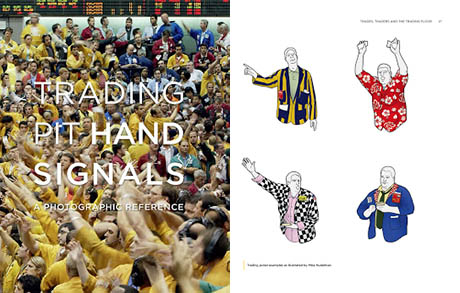
IMAGE: A photographic guide to open-outcry trading pit hand signals, from a book to look forward to in 2014. Images via the Trading Pit Blog.
The Secret Financial Life of Food: From Commodities Markets to Supermarkets
Sadly, The Secret Financial Life of Food is not a terrifically well-written book. Still, it made my list because its subject matter is unique and completely fascinating: in it, author Kara Newman examines the role that the commodities market has played in shaping culinary history, unpacking such arcane curiosities as the corn derivatives market, cheddar cheese futures (cheddar is the only cheese variety traded on the Chicago Mercantile Exchange), and the Great Salad Oil Swindle of November 1963, which caused hundreds of millions of dollars in losses, but was overlooked in the drama surrounding JFK’s assassination later the same month. Arcane, indeed, but increasingly relevant: as Newman points out, the amount of money invested in food commodities increased from $13 billion in 2003 to $260 billion in 2008, spurred by the profits to be made in a world of increasing food demand and, as climate change kicks in, decreasing supply.
Food: An Atlas
What do you see when you map the world through food? According to Food: An Atlas, a crowd-sourced, crowd-funded, “guerrilla cartography” project led by UC Berkeley professor Darin Jensen, you see the distribution patterns of the global almond trade but also the lost agrarian landscapes of Los Angeles, the geography of taco trucks of East Oakland and the United States beershed, as well as the rise of foodbanks in the UK, and much more besides. Available as a free PDF as well as in print form, this compilation of more than seventy food maps is less of a definitive atlas and more of an inspiring guidebook to the kinds of cartographic questions you can ask about food: it’s hard to read it without coming up with ten more foodscape maps you can’t wait to create.
Gulp: Adventures on the Alimentary Canal
The prolific Mary Roach, fresh from tackling the science of corpses, sex, and space travel, takes the reader along on the journey our food makes every day, from nose to tail (or, to be precise, to Elvis Presley’s constipated mega-colon). Gulp is stuffed full of enjoyably peculiar details, from a section on how dogs and cats taste food, to the fact that human hair is (a) Kosher, and (b) as much as 14 percent L-cysteine, an amino acid used to make meat flavorings and ersatz soy sauce. Although Roach’s endless, schoolboy-humor footnotes (making fun of EneMan, the world’s only enema mascot, for instance, or academic papers on “fecal odorgrams”) can get a tiny bit tiring after a while, it’s hard not to enjoy her infectious curiosity.
Tutti Frutti with Bompas & Parr and Friends
Full disclosure, I contributed a short essay (about spaces of banana control) to this exuberant collection of fruit eclectica. Still, at the risk of self-promotion, I couldn’t leave out a book that contains a recipe for bioluminescent durian sauce, a guide to the pineapple as architectural ornament, and, perhaps most thrillingly, a sustained meditation on the reason artificial raspberry-flavored sweets and soda are blue. You will never look at your fruit bowl the same way again.
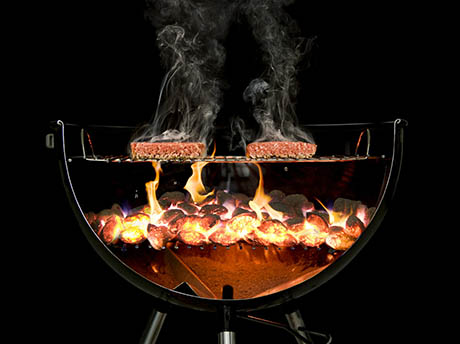
IMAGE: Photograph courtesy The Cooking Lab/Modernist Cuisine.
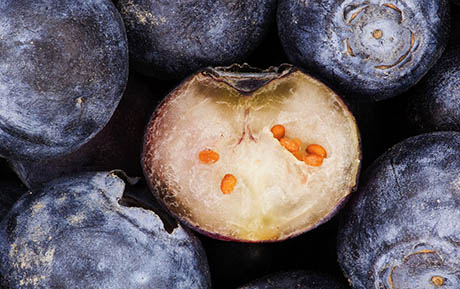
IMAGE: Photograph courtesy The Cooking Lab/Modernist Cuisine.
The Photography of Modernist Cuisine
Nathan Myrhvold may be a patent troll, but he certainly knows how to take an amazing food photograph.When Modernist Cuisine, his six volume, $450 encyclopedia unpacking the mysteries of sous-vide cuisine and the relationship between ultrasonic cavitation and crispy French fries, came out in 2011, reviewers spent more time marveling at the incredible images of a Weber grill sliced in half to reveal glowing coals and the browning base of the burgers, or a planet-sized blueberry, so close-up you could see its normally invisible orange seeds, than discussing its contents. Released this autumn, The Photography of Modernist Cuisine reproduces some of the best images at an even larger scale, and, best of all, reveals exactly how they were made. That Weber grill? Thirty separate photos, cropped and combined. Pins, toothpicks, Plexiglass, and a band saw all play an important role, but there are also lighting and backdrop techniques you can copy at home. No more Martha Stewart-style #fails for your food snaps!
• • •
This list only includes books that were published in 2013, but, even so, I’m sure I’ve missed a few gems (let me know in the comments). Gizmodo’s full list is well worth a read: it includes Venue favourites The End of Night and Wild Ones, as well as some fantastic-sounding recommendations for books about secret plutonium-manufacturing cities, hot-air ballooning, New York City’s Sanitation Department, and much more. Time to get reading!

